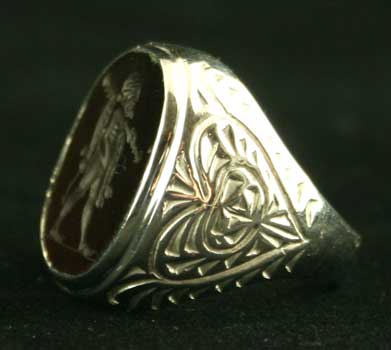White Gold Ring Featuring a Roman Carnelian Intaglio of a Bust of Herakles, 100 CE - 300 CE
Carnelian, Gold
FJ.6840
This Genuine Ancient Seal Has Been Set in a Modern 18 Karat White Gold Rin The art of glyptics, or carving images on colored precious stones, is probably one of...
This Genuine Ancient Seal Has Been Set in a Modern 18 Karat White Gold Rin
The art of glyptics, or carving images on colored precious stones, is probably one of the oldest known to humanity. Intaglios, gems with an incised design, were made as early as the fourth and third millennia B.C. in Mesopotamia and the Aegean Islands. They exhibit a virtuosity of execution that suggests an old and stable tradition rooted in the earliest centuries. The tools required for carving gems were simple: a wheel with a belt-drive and a set of drills. Abrasives were necessary since the minerals used were too hard for a metal edge. A special difficulty of engraving intaglios, aside from their miniature size, was that the master had to work with a mirror-image in mind.
Herakles is one of the most popular gods of the entire Greek and Roman pantheon. His mighty strength and legendary feats allowed him to become an immortal and live in Mt. Olympus as one of the gods. Here, he is represented wearing the skin of the Nemean lion sporting a thick, full beard and carrying his club over his shoulder. The tales of this hero have entertained generations from antiquity up to today. The greatness of Herakles has been captured in this portrait, a stunning centerpiece to this gorgeous ring. Today, this ancient seal is a symbol for steadfast strength, vigor, and fortitude. Wearing this ring, one would never give up on any task; after all, the gods look favorably down upon you.
The art of glyptics, or carving images on colored precious stones, is probably one of the oldest known to humanity. Intaglios, gems with an incised design, were made as early as the fourth and third millennia B.C. in Mesopotamia and the Aegean Islands. They exhibit a virtuosity of execution that suggests an old and stable tradition rooted in the earliest centuries. The tools required for carving gems were simple: a wheel with a belt-drive and a set of drills. Abrasives were necessary since the minerals used were too hard for a metal edge. A special difficulty of engraving intaglios, aside from their miniature size, was that the master had to work with a mirror-image in mind.
Herakles is one of the most popular gods of the entire Greek and Roman pantheon. His mighty strength and legendary feats allowed him to become an immortal and live in Mt. Olympus as one of the gods. Here, he is represented wearing the skin of the Nemean lion sporting a thick, full beard and carrying his club over his shoulder. The tales of this hero have entertained generations from antiquity up to today. The greatness of Herakles has been captured in this portrait, a stunning centerpiece to this gorgeous ring. Today, this ancient seal is a symbol for steadfast strength, vigor, and fortitude. Wearing this ring, one would never give up on any task; after all, the gods look favorably down upon you.
